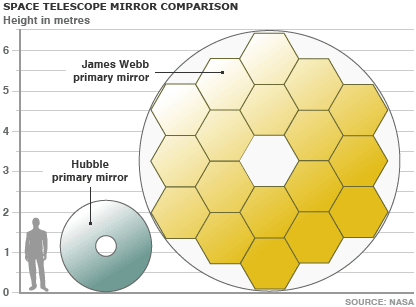James Webb Space Telescope

Main components of the James Webb Space Telescope. Inset: The orbit in which the telescope will move.

The mirrors of the James Webb Space Telescope and Hubble Space Telescope compared.
James Webb Space Telescope is a large, space-borne telescope, of unprecedented sensitivity and resolving power, which carries out observations at wavelengths between those at the red end of the visible spectrum and the middle of the infrared range. It is named after James E Webb, NASA Administrator during the Apollo lunar exploration era and was previously known as the Next Generation Space Telescope (NGST).
The James Webb Space Telescope (JWST) has an 18-segment primary mirror 6.6 meters (22 feet) in diameter – over 2.5 times as large as the 2.4-meter mirror of the Hubble Space Telescope. Each of the hexagonal mirror segments measures 1.3 meters (4.3 feet) in diameter and weighs just 20 kilograms (46 pounds). They are made of the lightweight metal beryllium. Although the completed primary mirror is much larger than that of Hubble, it weighs roughly half as much. JWST is stationed much further from Earth so that its equipment can remain cold and free from terrestrial infrared "noise". Three principal instruments gather images of the Universe in the infrared region of the spectrum.
JWST is expected to provide a vast amount of new information on the structure
of circumstellar disks around young stars,
including high-resolution images showing details, such as gaps, which may
indicate the presence of newly-formed planets. It is also capable of
detecting the presence of exoplanets directly due to their infrared emission. This is because planets are brighter
relative to their central stars in the infrared part of the spectrum than
they are at visible wavelengths. For example, Jupiter is 100 million times fainter than the Sun in the optical region, but only
10,000 times fainter in the infrared. JWST will also study the earliest
galaxies and some of the first stars formed after the Big
Bang. These early objects have a high redshift from our vantage-point,
meaning that the best observations of them are available in the infrared.
JWST was launched by an Ariane V rocket on 25 December 2021. It operates
from a Lissajous orbit about the
L2 Earth-Sun Lagrangian point, some 1.5
million kilometers from Earth.

